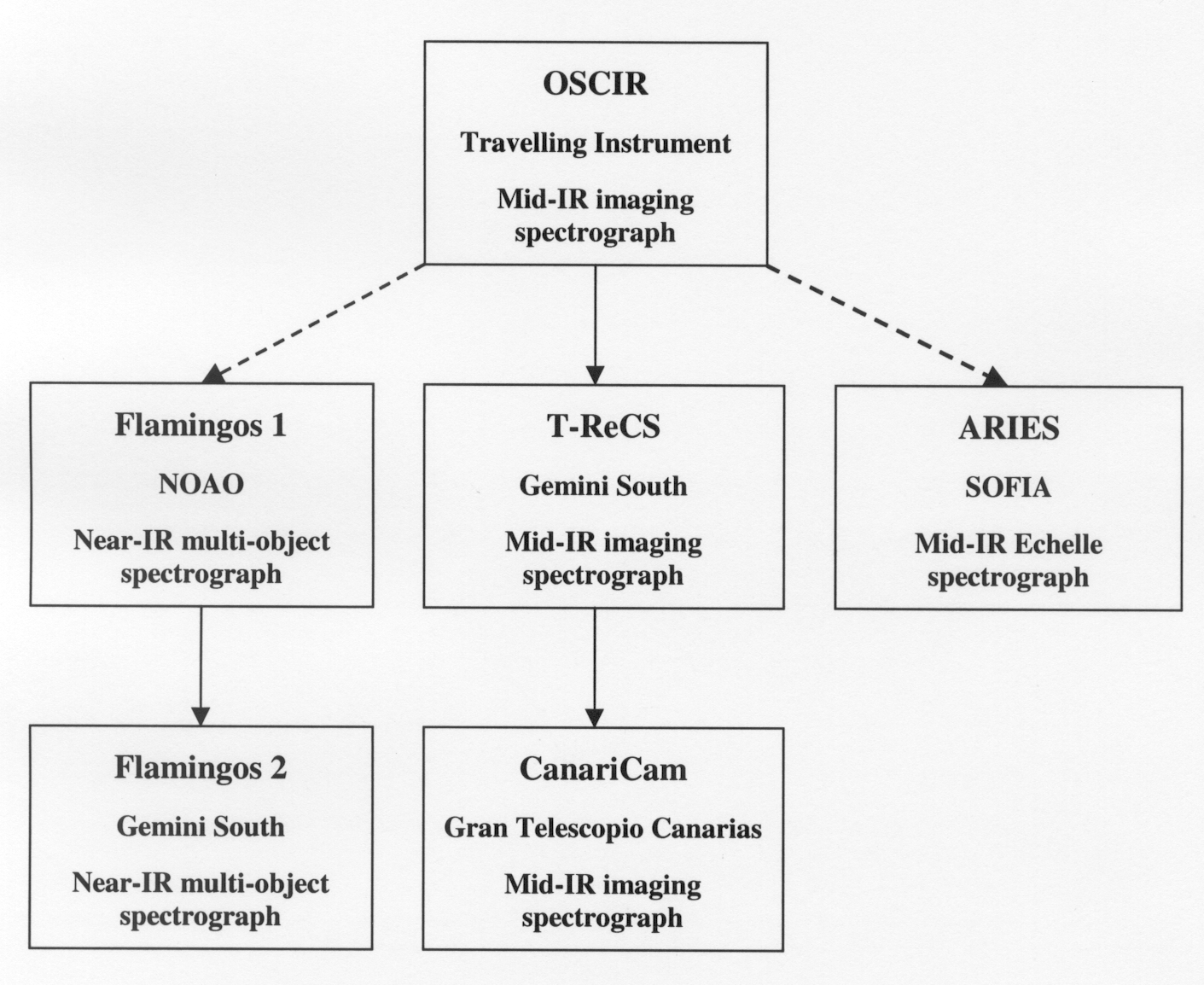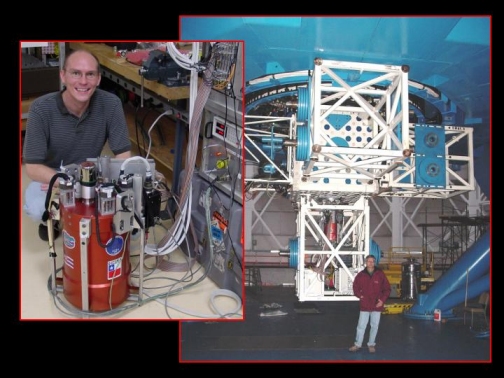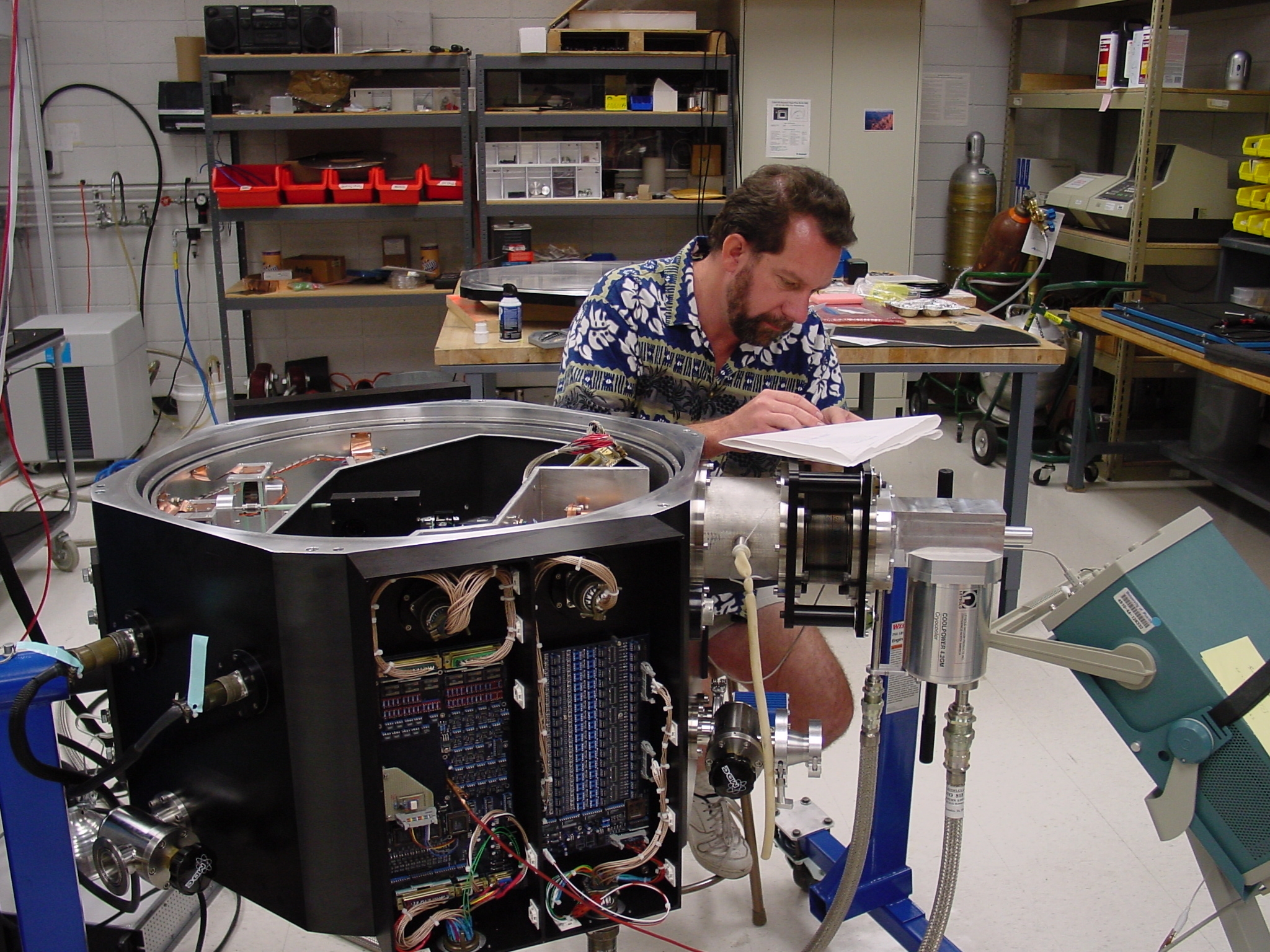
The family tree of University of Florida Infrared Instruments
The University of Florida (UF) has developed a family of astronomical instruments that use many of the same sub-systems. These various instruments are being used successfully at many telescopes. Although CanariCam is a new instrument and has many new capabilities, its shared properties with several other instruments provides additional confidence in its capabilities.
The UF instrument family is summarised in this diagram:

The original UF mid-infrared imaging spectrograph, OSCIR, was built as a travelling instrument. It has a 128x128-pixel detector from Boeing and low-resolution (R < 100) and high-resolution (R <700) spectroscopic capabilities at 10 microns using gratings.
OSCIR has been used as a test-bed for mid-infrared technology, allowing the UF group to come up with simple and reliable solutions to many basic problems such as obtaining an efficient optomechanical design, read-out electronics and the optimisation of the detector bias and temperature to obtain the best noise and sensitivity characteristics.
Originally used on the 3-m NASA IRTF in Mauna Kea (Hawaii) as a guest instrument, OSCIR has demonstrated its worth to such an extent that it has also been mounted on the 4-m telescope at Cerro Tololo InterAmerican Observatory, Keck, Gemini North (photograph below), and Gemini South.

UF student (now Gemini
Fellow) Scott Fisher (left) with OSCIR during lab tests prior to installation
on Gemini North, shown
at right with Charlie Telesco.
OSCIR is a compact instrument, and, although CanariCam will be a larger, these photographs give an idea of the scale - the OSCIR cryostat is the small red object in the middle of the Gemini Instrument Support Structure (behind Charlie Telesco), totally dwarfed by the telescope.
OSCIR has demonstrated diffraction-limited imaging capability and excellent image quality. (Note tha at 10 microns, the seeing can be negligible.) Compare this image of the protoplanetary disk of the star HR4796A taken with OSCIR at 18 microns with the 4-m reflector at Cerro Tololo Interamerican Observatory (CTIO)...
The protoplanetary
disk of HR 4796A observed with OSCIR on the 4-m Telescope at CTIO.
Image: University
of Florida Astronomy Group.
....with this one taken with OSCIR at the same wavelength but with the 10-m Keck II Telescope.
The protoplanetary
disk of HR 4796A observed with OSCIR on the Keck II Telescope at Mauna
Kea.
Image: University
of Florida Astronomy Group.
The theoretical diffraction limit at Keck (Dawes limit) is 1.16 lambda/D = 0.44 arcseconds. We can see that knots on either side of the central source that are separated by 0.9 arcseconds are easily resolved in the Keck images, but cannot be seen in the CTIO frames where they are slightly smaller than the theoretical diffraction limit. CanariCam may do even better than this as the GTC is slightly larger than Keck, with a maximum diameter of 10.4-m.
T-ReCS, the facility mid-infrared imager for Gemini South builds on the experience gained with OSCIR. It uses a larger format detector and a better spectroscopic capability as well as numerous other improvements that are less obvious to the end user. Because it is a dedicated Gemini instrument, it is optimised for the Gemini telescope and optical system. This allows it to attain an unusually good level of optical performance with the Strehl ratio at some wavelengths being as high as 0.97. Likewise, CanariCam will be optimised for performance on the GTC.
The following image shows the detector end (lower left) of the T-ReCS cryostat before sealing in the UF IR Lab. Some of the gold-coated internal optics are seen.
The detector end of T-ReCS.
T-ReCS was assembled in the laboratories at the Astronomy Department of the University of Florida and is due to be delivered to Gemini South in early 2002. It will be offered to users of the telescope in summer 2002.
The photo below left shows UF electronics engineer Kevin Hanna working on the T-ReCS detector fan-out board. A face-on view of the bottom (i.e., the detector side) of the open cryostat is shown in the right-hand image. Note the Ferrofluidic feedthrough assembly at the top of the dewar that contains several entrance windows any of which can be selected during the observations. The first lab science images were taken with T-ReCS in August 2001.

In the photo, senior electonics engineer Kevin Hanna is shown working on the T-ReCS detector fanout board.
CanariCam can be considered in many ways an upgraded version of T-ReCS. Users of the GTC will have the assurance of knowing that T-ReCS will have completed its commissioning before metal is cut on CanariCam and that the CanariCam concept will have been proved with T-ReCS on an 8-m telescope. By the time that CanariCam is mounted on the GTC there will have been a year and a half of operational experience with T-ReCS allowing many of the typical operational and observational problems to be identified and solved. Apart from that, both instruments have benefitted enormously from the experience of OSCIR on Keck and Gemini, which has proven the techniques that will be used with CanariCam on the GTC.
The closed T-ReCS cryostat is shown below in the IR lab at the University of Florida. Note the hexagonal shape of the cryostat shown here with UF mechanical engineer Jeff Julian and two UF students.
Senior cryomechanical
engineer for T-ReCS and CanariCam, Jeff Julian, and UF student
working on the T-ReCS
cryostat in the Infrared Lab at the University of Florida.
With T-ReCS in the southern
hemisphere and CanariCam in the north, both on outstanding telescopes at
outstanding sites, observers will have the capability of observing the
entire sky in unprecedented quality with the best mid-infrared instrumentation
that exists in the world.